The Petrogenesis of Early Permian Granodiorites in the Northern Segment of the Changning-Menglian Suture Zone, Western Yunnan, and Their Tectonic Implications
Abstract
1. Introduction
2. Geological Setting
3. Sample Collection and Analytical Methods
4. Results
4.1. Zircon U-Pb Dating
4.2. Whole-Rock Element Composition
4.3. Trace Elements
4.4. Sr-Nd Isotope Data
4.5. Zircon Hf Isotope Characteristics
5. Discussion
5.1. Emplacement Age of Paleo-Tethyan Granitic Magma
5.2. Petrogenesis
5.2.1. Rock Type
5.2.2. Magma Source
5.2.3. Magma Evolution Process
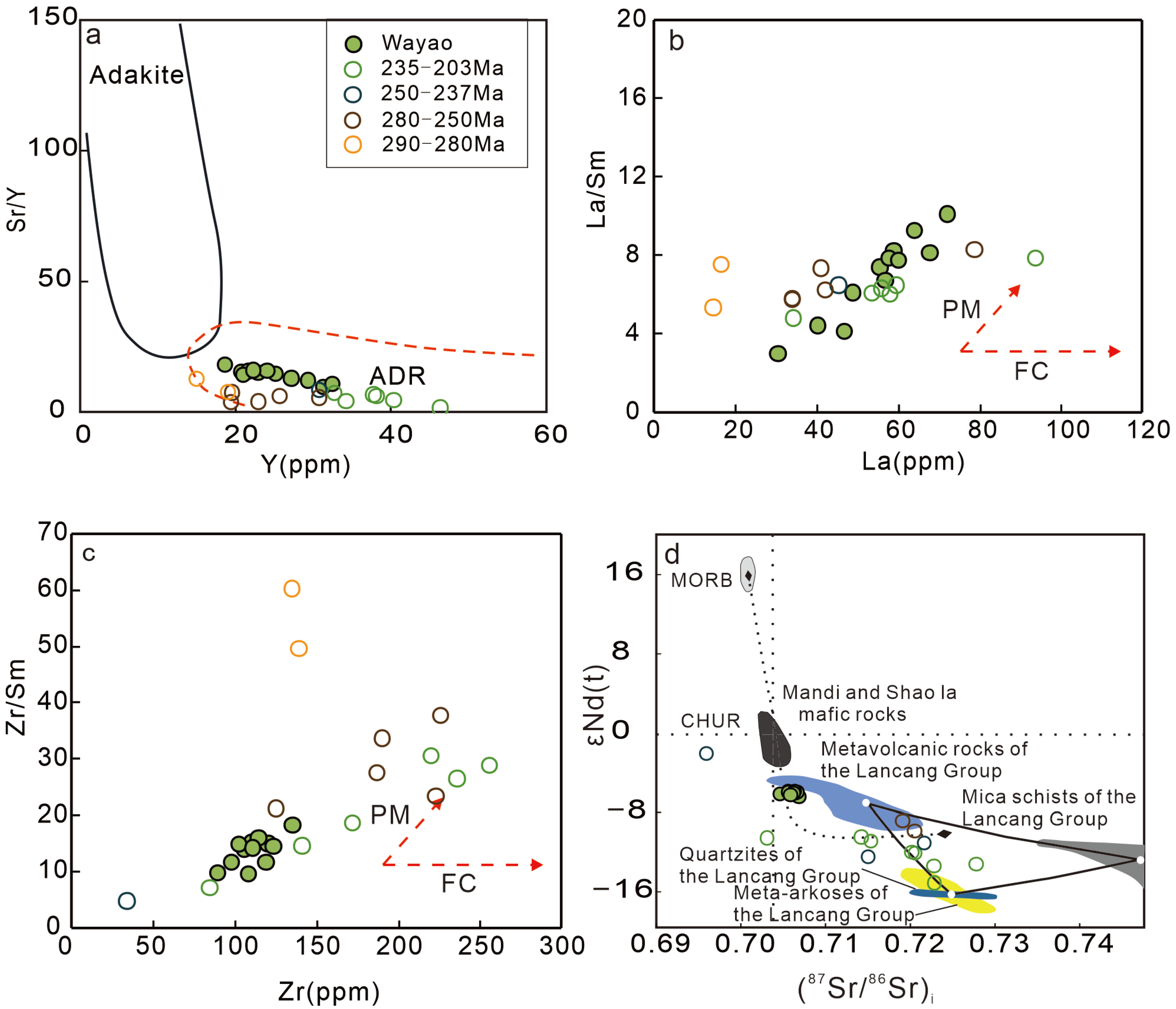
5.3. Tectonic Setting of Late Paleozoic Granite Formation and Constraints on the Eastward Subduction Process of the Paleo-Tethyan Ocean

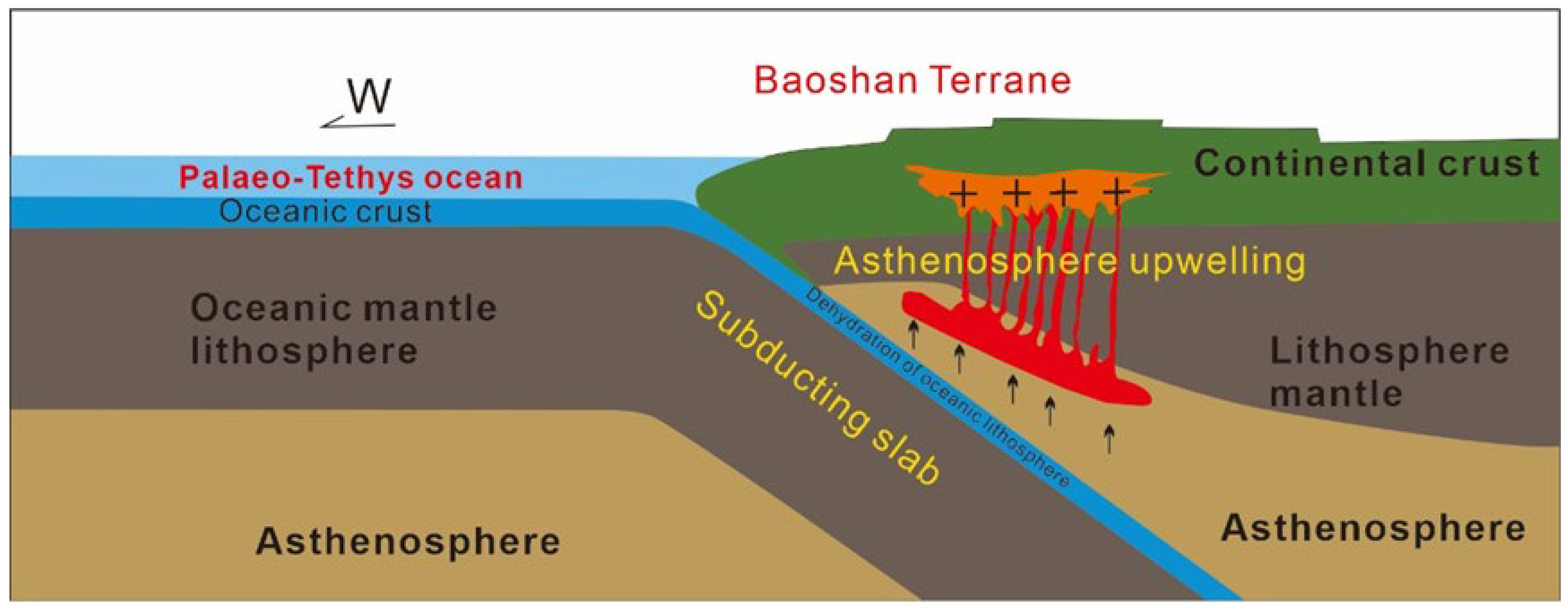
6. Conclusions
Author Contributions
Funding
Data Availability Statement
Conflicts of Interest
References
- Sengör, A.M.C. Tectonics of the Tethysides: Orogenic Collage Development in a Collisional Setting. Annu. Rev. Earth Planet. Sci. 1987, 15, 213–244. [Google Scholar] [CrossRef]
- Metcalfe, I. Permian Tectonic Framework and Palaeogeography of SE Asia. J. Asian Earth Sci. 2002, 20, 551–566. [Google Scholar] [CrossRef]
- Deng, J.; Wang, Q.F.; Li, G.J.; Li, C.S.; Wang, C.M. Tethys Evolution and Spatiotemporal Distribution of Ore Deposits in the Sanjiang Region, Southwestern China. Gondwana Res. 2014, 26, 419–437. [Google Scholar] [CrossRef]
- Deng, J.; Wang, Q.F.; Li, G.J.; Santosh, M. Cenozoic Tectono-Magmatic and Metallogenic Processes in the Sanjiang Region, Southwestern China. Earth-Sci. Rev. 2014, 138, 268–299. [Google Scholar] [CrossRef]
- Metcalfe, I. Gondwana Dispersion and Asian Accretion: Tectonic and Paleogeographic Evolution of Eastern Tethys. J. Asian Earth Sci. 2013, 66, 1–33. [Google Scholar] [CrossRef]
- Shen, S.Z.; Shi, G.R.; Fang, Z.J. Permian brachiopods from the Baoshan and Simao Blocks in Western Yunnan, China. J. Asian Earth Sci. 2002, 20, 665–682. [Google Scholar] [CrossRef]
- Lai, S.C.; Qin, J.F.; Li, X.J.; Zang, W.J. Geochemistry and Sr-Nd-Pb isotopic compositions of the Ganlongtang-Nongba ophiolite in the Changning-Menglian suture zone. Acta Petrol. Sin. 2010, 26, 3195–3205, (In Chinese with English abstract). [Google Scholar]
- Li, G.J.; Wang, Q.F.; Huang, Y.H.; Chen, F.C.; Dong, P. Discovery of Hadean-Mesoarchean crustal materials in the northern Sibumasu block and its significance for Gondwana reconstruction. Precambrian Res. 2015, 271, 118–137. [Google Scholar] [CrossRef]
- Hennig, D.; Lehmann, B.; Frei, D.; Belyatsky, B.; Zhao, X.F.; Cabral, A.R.; Zeng, P.S.; Zhou, M.F.; Schmidt, K. Early Permian seafloor to continental arc magmatism in the eastern Paleo-Tethys: U–Pb age and Nd–Sr isotope data from the southern Lancangjiang Zone, Yunnan, China. Lithos 2009, 113, 408–422. [Google Scholar] [CrossRef]
- Jian, P.; Liu, D.Y.; Kröner, A.; Zhang, Q.; Wang, Y.Z.; Sun, X.M.; Zhang, W. Devonian to Permian plate tectonic cycle of the Paleo-Tethys Orogen in southwest China (II): Insights from zircon ages of ophiolites, arc/back-arc assemblages and within-plate igneous rocks and generation of the Emeishan CFB province. Lithos 2009, 113, 767–784. [Google Scholar] [CrossRef]
- Wang, C.M.; Deng, J.; Santosh, M.; McCuaig, T.C.; Lu, Y.J.; Carranza, E.J.M.; Wang, Q.F. Age and origin of the Bulangshan and Mengsong granitoids and their significance for post-collisional tectonics in the Changning–Menglian Paleo-Tethys Orogen. J. Asian Earth Sci. 2015, 113, 656–676. [Google Scholar] [CrossRef]
- Li, R.Y.; Sun, X.; Li, Q.; Zheng, X.; Xiao, K.; Zheng, M.J. Potential of porphyry copper mineralization in the Triassic Yunxian-Jinggu arc, in the Sanjiang orogen, SW China. Ore Geol. Rev. 2024, 164, 105832. [Google Scholar] [CrossRef]
- Dong, M.L.; Dong, G.C.; Mo, X.X.; Santosh, M.; Zhu, D.C.; Yu, J.C.; Nie, F.; Hu, Z.C. Geochemistry, zircon U-Pb geochronology and Hf isotopes of granites in the Baoshan Block, Western Yunnan: Implications for Early Paleozoic evolution along the Gondwana margin. Lithos 2013, 179, 36–47. [Google Scholar] [CrossRef]
- Deng, J.; Wang, C.M.; Zi, J.W.; Xia, R.; Li, Q. Constraining subduction-collision processes of the Paleo-Tethys along the Changning-Menglian suture: New zircon U-Pb ages and Sr-Nd-Pb-Hf-O isotopes of the Lancang batholith. Gondwana Res. 2018, 62, 75–92. [Google Scholar] [CrossRef]
- Fan, W.M.; Wang, Y.J.; Zhang, Y.H. Paleotethyan subduction process revealed from Triassic blueschists in the Lancang tectonic belt of Southwest China. Tectonophysics 2015, 662, 95–108. [Google Scholar] [CrossRef]
- Jian, P.; Liu, D.Y.; Sun, X.M. SHRIMP dating of Jicha Alaskan-type gabbro in West Yunnan Province: Evidence for the early Permian subduction. Acta Geol. Sin. 2004, 78, 165–170, (In Chinese with English abstract). [Google Scholar]
- Peng, T.P.; Wang, Y.J.; Zhao, G.C.; Fan, W.M.; Peng, B.X. Arc-Like Volcanic Rocks from the Southern Lancangjiang Zone, SW China: Geochronological and Geochemical Constraints on Their Petrogenesis and Tectonic Implications. Lithos 2008, 102, 358–373. [Google Scholar] [CrossRef]
- Jia, Z.; Li, W.; Sha, J.; Li, S.; Chen, F.; Deng, M. Genesis of the Yunlong Sn deposit in the Chongshan Shear Zone, Western Yunnan, SW China. J. Geochem. Explor. 2025, 271, 107690. [Google Scholar] [CrossRef]
- Wang, B.D.; Wang, L.Q.; Pan, G.T.; Yin, F.G.; Wang, D.B.; Tang, Y. U-Pb zircon dating of early Paleozoic gabbro from the Nantinghe ophiolite in the Changning-Menglian suture zone and its geological implication. Chin. Sci. Bull. 2013, 58, 920–930. [Google Scholar] [CrossRef]
- Wang, D.B.; Luo, L.; Tang, Y.; Yin, F.G.; Wang, B.D.; Wang, L.Q. Zircon U-Pb dating and petrogenesis of early Paleozoic adakites from the Niujingshan ophiolitic mélange in the Changning-Menglian suture zone and its geological implications. Acta Petrol. Sin. 2016, 32, 2317–2329. [Google Scholar]
- Liu, G.C.; Sun, Z.B.; Zeng, W.T.; Feng, Q.L.; Huang, L.; Zhang, H. The age of Wanhe ophiolitic mélange from Mengku area, Shuangjiang County, western Yunnan Province, and its geological significance. Acta Petrol. Mineral. 2017, 36, 163–174. [Google Scholar]
- Liu, G.C.; Sun, Z.B.; Zi, J.W.; Santosh, M.; Zhao, T.Y.; Feng, Q.L.; Chen, G.Y.; Nie, X.M.; Li, J.; Zhang, S.T. Proto-tethys ophiolitic mélange in SW Yunnan: Constraints from zircon U-Pb geochronology and geochemistry. Geosci. Front. 2021, 12, 287–303. [Google Scholar] [CrossRef]
- Peng, Z.M.; Fu, Y.Z.; Wang, G.Z.; Guan, J.L.; Geng, Q.R.; Hu, J.F.; Liu, Y.H.; Zhang, Z. The results of geochronological, geochemical and Sr-Nd-Hf isotopic investigations on amphibolites in the Qingping region, Changning-Menglian suture zone. Acta Geol. Sin. 2020, 94, 511–526. [Google Scholar]
- Wu, Z.; Wang, B.D.; Wang, D.B.; Liu, H.; Zhou, F. Zircon U-Pb dating of early Paleozoic Adakites from Nantinghe Ophiolitic Mélange in Changning-Menglian suture zone and its geological implications. Earthq. Sci. 2020, 45, 3003–3013. [Google Scholar]
- Nie, X.M.; Feng, Q.L.; Qian, X.; Wang, Y.J. Magmatic record of Prototethyan evolution in SW Yunnan, China: Geochemical, zircon U-Pb geochronological and Lu-Hf isotopic evidence from the Huimin metavolcanic rocks in the southern Lancangjiang zone. Gondwana Res. 2015, 28, 757–768. [Google Scholar] [CrossRef]
- Lehmann, B.; Zhao, X.F.; Zhou, M.F.; Du, A.D.; Mao, J.W.; Zeng, P.S.; Henjes-Kunst, F.; Heppe, K. Mid-Silurian back-arc spreading at the northeastern margin of Gondwana: The Dapingzhang dacite-hosted massive sulfide deposit, Lancangjiang zone, southwestern Yunnan, China. Gondwana Res. 2013, 24, 648–663. [Google Scholar] [CrossRef]
- Ru, S.S.; Li, F.; Wu, J. Geochemical characteristics and geochronology of granodiorite porphyry in Dapingzhang Cu-polymetallic deposit, Yunnan Province. Acta Petrol. Mineral. 2012, 31, 531–540, (In Chinese with English abstract). [Google Scholar]
- Mao, X.C.; Wang, L.Q.; Li, B.; Wang, B.D.; Wang, D.B.; Yin, F.G.; Sun, Z.M. Discovery of Late Silurian volcanic rocks in the Dazhonghe area of Yunxian-Jinggu volcanic arc belt and its geological significance. Acta Petrol. Sin. 2012, 28, 1517–1528, (In Chinese with English abstract). [Google Scholar]
- Lai, S.C.; Qin, J.F.; Li, X.J.; Wen, J. Geochemistry of the OIB-Type Basalt from the Wumulong-Tongchangjie Area, Changning-Menglian Suture Zone: Its Petrogenesis and Tectonic Implications. Earth Sci. Front. 2010, 17, 44–52, (In Chinese with English abstract). [Google Scholar]
- Wu, H.R.; Boulter, C.A.; Ke, B.J.; Stow, D.A.V.; Wang, Z.C. The Chang-ning-Menglian suture zone: A segment of the major Cathaysian-Gondwana divide in Southeast Asia. Tectonophysics 1995, 242, 267–280. [Google Scholar] [CrossRef]
- Feng, Q.L. Stratigraphy of volcanic rocks in the Changning-Menglian Belt in southwestern Yunnan, China. J. Asian Earth Sci. 2002, 20, 657–664. [Google Scholar] [CrossRef]
- Jian, P.; Liu, D.Y.; Kröner, A.; Zhang, Q.; Wang, Y.Z.; Sun, X.M.; Zhang, W. Devonian to Permian plate tectonic cycle of the Paleo-Tethys Orogen in southwest China (I): Geochemistry of ophiolites, arc/back-arc assemblages and within-plate igneous rocks. Lithos 2009, 113, 748–766. [Google Scholar] [CrossRef]
- Zi, J.W.; Cawood, P.A.; Fan, W.M.; Tohver, E.; Wang, Y.J.; McCuaig, T.C.; Peng, T.P. Late Permian–Triassic magmatic evolution in the Jinshajiang orogenic belt, SW China and implication for orogenic processes following closure of the Paleo-Tethys. Am. J. Sci. 2013, 313, 81–112. [Google Scholar] [CrossRef]
- Zi, J.W.; Cawood, P.A.; Fan, W.M.; Wang, Y.J.; Tohver, E.; McCuaig, T.C. Generation of Early Indosinian enriched mantle-derived granitoid pluton in the Sanjiang Orogen (SW China) in response to closure of the Paleo-Tethys. Lithos 2012, 140, 166–182. [Google Scholar] [CrossRef]
- Zi, J.W.; Cawood, P.A.; Fan, W.M.; Wang, Y.J.; Tohver, E.; McCuaig, T.C.; Peng, T.P. Triassic collision in the Paleo-Tethys Ocean constrained by volcanic activity in SW China. Lithos 2012, 144, 145–160. [Google Scholar] [CrossRef]
- Zhu, W.G.; Zhong, H.; Wang, L.Q.; He, D.F.; Ren, T.; Fan, H.P.; Bai, Z.J. Petrogenesis of the basalts and rhyolite porphyries of the Minle copper deposit, Yunnan: Geochronological and geochemical constraints. Acta Petrol. Sin. 2011, 27, 2694–2708. [Google Scholar]
- Wang, C.M.; Deng, J.; Lu, Y.J.; Bagas, L.; Kemp, A.I.S.; McCuaig, T.C. Age, nature, and origin of Ordovician Zhibenshan granite from the Baoshan terrane in the Sanjiang region and its significance for understanding Proto-Tethys evolution. Int. Geol. Rev. 2015, 57, 1922–1939. [Google Scholar] [CrossRef]
- Deng, J.; Wang, C.M.; Bagas, L.; Selvaraja, V.; Jeon, H.; Wu, B.; Yang, L.F. Insights into ore genesis of the Jinding Zn–Pb deposit, Yunnan Province, China: Evidence from Zn and in-situ S isotopes. Ore Geol. Rev. 2017, 90, 943–957. [Google Scholar] [CrossRef]
- Wang, Y.J.; Zhang, A.M.; Fan, W.M.; Peng, T.P.; Zhang, F.F.; Zhang, Y.H.; Bi, X.W. Petrogenesis of Late Triassic post-collisional basaltic rocks of the Lancangjiang tectonic zone, Southwest China, and tectonic implications for the evolution of the eastern Paleotethys: Geochronological and geochemical constraints. Lithos 2010, 120, 529–546. [Google Scholar] [CrossRef]
- Peng, T.P.; Wilde, S.A.; Wang, Y.J.; Fan, W.M.; Peng, B.X. Mid-Triassic felsic igneous rocks from the southern Lancangjiang Zone, SW China: Petrogenesis and implications for the evolution of Paleo-Tethys. Lithos 2013, 168–169, 15–32. [Google Scholar] [CrossRef]
- Huang, Y.H.; Deng, J.; Li, G.J.; Meng, F.Q.; Mao, F.X.; Zhang, P.F. Metallogenic process and material sources of the Laochang concealed porphyry-skarn Mo deposit, western Yunnan. Acta Petrol. Sin. 2017, 33, 2099–2114, (In Chinese with English abstract). [Google Scholar]
- Wilson, A.D. A new method for the determination of ferrous iron in rocks and minerals. Bull. Geol. Surv. Great Br. 1955, 9, 56–58. [Google Scholar]
- Andrade, S.; Hypolito, R.; Ulbrich, H.H.G.J.; Silva, M.L. Iron II oxide determination in rocks and minerals. Chem. Geol. 2002, 182, 85–89. [Google Scholar] [CrossRef]
- Wang, C.M.; Chen, L.; Bagas, L.; Lu, Y.J.; He, X.Y.; Lai, X.R. Zircon U–Pb dating, geochemistry and Sr–Nd–Hf isotopes for the Taishanmiao aluminous A-type granites: Implications for Early Cretaceous lithospheric thinning of the North China Craton. Int. J. Earth Sci. 2016, 105, 1563–1589. [Google Scholar] [CrossRef]
- Jiang, S.Y.; Han, F.; Shen, J.Z.; Palmer, M.R. Chemical and Rb–Sr, Sm–Nd isotopic systematics of tourmaline from the Dachang Sn-polymetallic ore deposit, Guangxi Province, P.R. China. Chem. Geol. 1999, 157, 49–67. [Google Scholar] [CrossRef]
- Middlemost, E.A.K. Naming materials in the magma/igneous rock system. Earth-Sci. Rev. 1994, 37, 215–224. [Google Scholar] [CrossRef]
- Peccerillo, R.; Taylor, S.R. Geochemistry of Eocene calc-alkaline volcanic rocks from the Kastamonu area, northern Turkey. Contrib. Mineral. Petrol. 1976, 58, 63–81. [Google Scholar] [CrossRef]
- Shand, S.J. The Eruptive Rocks; John Wiley & Sons: New York, NY, USA, 1947; pp. 1–444. [Google Scholar]
- Dong, G.C.; Mo, X.X.; Zhao, Z.D.; Zhu, D.C.; Goodman, R.C.; Kong, H.L.; Wang, S. Zircon U–Pb dating and the petrological and geochemical constraints on Lincang granite in Western Yunnan, China: Implications for the closure of the Paleo-Tethys Ocean. J. Asian Earth Sci. 2013, 62, 282–294. [Google Scholar] [CrossRef]
- Cong, F.; Wu, F.Y.; Li, W.C.; Mou, C.L.; Huang, X.M.; Wang, B.D.; Hu, F.Y.; Peng, Z.M. Origin of the Triassic Lincang granites in the southeastern Tibetan Plateau: Crystallization from crystal mush. Lithos 2020, 360, 105452. [Google Scholar] [CrossRef]
- Sun, S.S.; McDonough, W.F. Chemical and isotopic systematics of oceanic basalts: Implications for mantle composition and processes. In Magmatism in the Ocean Basins; Saunders, A.D., Norry, M.J., Eds.; Geological Society: London, UK, 1989; Volume 42, pp. 313–345. [Google Scholar]
- Zhao, F.; Li, G.J.; Wang, Q.F.; Xue, S.C. Discovery of multi-crustal rejuvenations for the formation of the Lincang granitic batholith, Southwest China: Magmatism relating to Changning–Menglian Paleo–Tethyan termination. Int. Geol. Rev. 2022, 64, 970–986. [Google Scholar] [CrossRef]
- Huang, X.; Dou, J.Z.; Wu, G.H.; He, j.; Siebel, W.; Chen, F.K. Source rocks control the geochemical diversity of granite: The Lincang pluton in the western Yunnan Tethyan belt, SW China. Lithos 2021, 382, 105950. [Google Scholar] [CrossRef]
- Xiao, Q.R.; Wang, Q.; Liu, Z.Y.; Xiong, F.H.; Fan, L.; Zhao, H.; Gong, T.T. Petrogenesis and tectonic implications of the early Paleozoic granites in the Lincang granitic batholith, southwestern China: Constraints from geochronology, geochemistry and Hf isotopes. Ore Energy Resour. Geol. 2023, 15, 100022. [Google Scholar] [CrossRef]
- Xie, J.-C.; Zhu, D.-C.; Wang, Q.; Cawood, P.A.; Zhao, Z.D.; Zhan, Q.Y.; Fan, J.H.; Wang, Y. Generation of isotopically enriched giant Lincang Batholith by disequilibrium melting of the heterogeneous lower crust. Lithos 2024, 488, 107803. [Google Scholar] [CrossRef]
- Wen, D.J.; Chung, S.L.; Lee, H.Y.; Zhang, Y.Q.; Xie, Y.W.; Li, H.M.; Lo, C.H.; Lee, T.Y.; Wang, Y.H. Geochronology and geochemistry of the Lincang Granite Complex: Implications of the Indosinian Orogeny in Southeast Asia. In Proceedings of the EUG XI Symposium MS02; Brown, D., Ed.; European Union of Geosciences: Strasbourg, France, 2001. [Google Scholar]
- Yang, T.N.; Liang, M.J.; Fan, J.W.; Shi, P.L.; Zhang, H.R.; Hou, Z.H. Paleogene sedimentation, volcanism and deformation in eastern Tibet: Evidence from structures, geochemistry and zircon U-Pb dating in the Jian-Chuan basin, SW China. Gondwana Res. 2014, 26, 521–535. [Google Scholar] [CrossRef]
- Chappell, B.W.; White, A.J.R. Two contrasting granite types. Pac. Geol. 1974, 8, 173–174. [Google Scholar]
- Loiselle, M.C.; Wones, D.R. Characteristics and origin of anorogenic granites. Geol. Soc. Am. Abstr. Programs 1979, 11, 468. [Google Scholar]
- Whalen, J.B.; Currie, K.L.; Chappell, B.W. A-type granites: Geochemical characteristics. Contrib. Mineral. Petrol. 1987, 95, 420–436. [Google Scholar] [CrossRef]
- Harris, N.B.W.; Pearce, J.A.; Tindle, A.G. Geochemical characteristics of collision zone magmatism. In Collision Tectonics; Coward, M.P., Ries, A.C., Eds.; Geological Society: London, UK, 1986; Volume 19, pp. 67–81. [Google Scholar]
- Bea, F.; Mazhari, A.; Montero, P.; Amini, S.; Ghalamghash, J. Zircon dating, Sr and Nd isotopes and element geochemistry of the Khalifan pluton, NW Iran: Evidence for Variscan magmatism in a supposedly Cimmerian superterrane. J. Asian Earth Sci. 2011, 40, 172–179. [Google Scholar] [CrossRef]
- Zhou, Z.; Thybo, H.; Artemieva, I.M.; Kusky, T.; Tang, C.C. Crustal melting and continent uplift by mafic underplating at convergent boundaries. Nat. Commun. 2024, 15, 9039. [Google Scholar] [CrossRef]
- Mulder, J.A.; Nebel, O.; Cawood, P.A. Tracking the evolution of magmatic volatiles from crustal melting to eruption. Nat. Commun. 2021, 12, 5234. [Google Scholar]
- Patiño-Douce, A.E. What do experiments tell us about the relative contributions of crust and mantle to the origin of granitic magmas? Geol. Soc. Lond. Spec. Publ. 1999, 168, 55–75. [Google Scholar] [CrossRef]
- Rapp, R.P.; Watson, E.B. Dehydration melting of metabasalt at 8–32 kbar: Implications for continental growth and crust-mantle recycling. J. Petrol. 1995, 36, 891–931. [Google Scholar] [CrossRef]
- Wareham, C.D.; Millar, I.L.; Vaughan, A.P.M. The generation of sodic granite magmas, western Palmer Land, Antarctic Peninsula. Contrib. Mineral. Petrol. 1997, 128, 81–96. [Google Scholar] [CrossRef]
- Defant, M.J.; Drummond, M.S. Derivation of some modern arc magmas by melting of young subducted lithosphere. Nature 1990, 347, 662–665. [Google Scholar] [CrossRef]
- Hao, L.R.; Yang, D.B.; Mu, M.S.; Yang, H.T.; Wang, A.Q.; Quan, Y.K.; Yan, X.Y. Neoarchean continental crust evolution of the southern North China Craton: Constrains from geochronology and geochemistry of the Dengfeng complex in the Jishan area. Int. J. Earth Sci. 2023, 112, 161–173. [Google Scholar] [CrossRef]
- Castillo, P.R.; Janney, P.E.; Solidum, R.U. Petrology and geochemistry of Camiguin Island, southern Philippines: Insights to the source of adakites and other lavas in a complex arc setting. Contrib. Mineral. Petrol. 1999, 134, 33–51. [Google Scholar] [CrossRef]
- Kemp, A.I.S.; Hawkesworth, C.J.; Foster, G.L.; Paterson, B.A.; Woodhead, J.D.; Hergt, J.M.; Gray, C.M.; Whitehouse, M.J. Magmatic and crustal differentiation history of granitic rocks from Hf-O isotopes in zircon. Science 2007, 315, 980–983. [Google Scholar] [CrossRef]
- Mushkin, A.; Navon, O.; Halicz, L.; Hartmann, G.; Stein, M. The petrogenesis of A-type magmas from the Amram Massif, Southern Israel. J. Petrol. 2003, 44, 815–832. [Google Scholar] [CrossRef]
- Hu, P.; Wu, Y.B.; Bauer, A.M.; Zhang, W.X.; He, Y. Zircon U-Pb geochronology and geochemistry of plagiogranites within a Paleozoic oceanic arc, the Erlangping unit of the Qinling accretionary orogenic belt: Petrogenesis and geological implications. Lithos 2021, 394–395, 106196. [Google Scholar] [CrossRef]
- Zhuang, Y.D.; Wu, Y.B.; Zhang, W.X.; Hu, P.; He, Y. Generation of continental crust by remelting of enriched oceanic crust in accretionary orogen: Geochemical evidence of granitoids in the Tongbai Orogen Central China. Lithos 2022, 420–421, 106718. [Google Scholar] [CrossRef]
- Watkins, J.M.; Clemens, J.D.; Treloar, P.J. Archaean TTGs as sources of younger granitic magmas: Melting of sodic metatonalites at 0.6–1.2 GPa. Contrib. Mineral. Petrol. 2007, 154, 91–110. [Google Scholar] [CrossRef]
- Owada, M.; Sakiyama, T.; Kamei, A.; Shimura, T.; Yuhara, M.; Tsukada, K.; Hokada, T.; Osanai, Y.; Nakano, N.; Adachi, T. Post-collisional K-rich mafic magmatism in the Sør Rondane Mountains, East Antarctica: Magmatic processes of layered syenite and mantle modification. Polar Sci. 2025, in press. [CrossRef]
- López, S.; Fernández, C.; Castro, A. Evolution of the Archaean continental crust: Insights from the experimental study of Archaean granitoids. Curr. Sci. 2006, 91, 607–621. [Google Scholar]
- Zheng, F.; Dai, L.Q.; Zhao, Z.F.; Zheng, Y.F.; Xu, Z. Recycling of Paleo-oceanic crust: Geochemical evidence from Early Paleozoic mafic igneous rocks in the Tongbai orogen, Central China. Lithos 2019, 328–329, 312–327. [Google Scholar] [CrossRef]
- Ferry, J.M.; Watson, E.B. New thermodynamic models and revised calibrations for the Ti-in-zircon and Zr-in-rutile thermometers. Contrib. Mineral. Petrol. 2007, 154, 429–437. [Google Scholar] [CrossRef]
- Baxter, E.F.; Feely, M. Mineralogical and textural evolution of the matrix in magma mingling: Implications for the rheology of granitic magmas. Mineral. Petrol. 2002, 74, 175–198. [Google Scholar]
- Nesbitt, H.W.; Young, G.M. Early Proterozoic climates and plate motions inferred from major element chemistry of lutites. Nature 1982, 299, 715–717. [Google Scholar] [CrossRef]
- Parrish, R.R.; Hodges, K.V. Isotopic constrains on the age and provenance of the lesser and Greater Himalayan sequences, Nepalese Himalaya. Geol. Soc. Am. Bull. 1996, 108, 904–911. [Google Scholar] [CrossRef]
- Miller, C.; Thöni, M.; Frank, W.; Grasemann, B.; Klötzli, U.; Guntli, P.; Draganits, E. The early Palaeozoic magmatic event in the Northwest Himalaya, India: Source, tectonic setting and age of emplacement. Geol. Mag. 2001, 138, 237–251. [Google Scholar] [CrossRef]
- Imayama, T.; Arita, K. Nd isotopic data reveal the material and tectonic nature of the Main Central Thrust zone in Nepal Himalaya. Tectonophysics 2008, 451, 265–281. [Google Scholar] [CrossRef]
- Visonà, D.; Rubatto, D.; Villa, I.M. The mafic rocks of Shao La (Kharta, S. Tibet): Ordovician basaltic magmatism in the greater Himalayan crystallines of central eastern Himalaya. J. Asian Earth Sci. 2010, 38, 14–25. [Google Scholar] [CrossRef]
- Rudnick, R.L.; Gao, S. Composition of the continental crust. Treatise Geochem. 2003, 3, 1–64. [Google Scholar]
- Zhong, D.L. Paleo-Tethyan Orogenic Belt in Western Sichuan and Yunnan Provinces; Science Press: Beijing, China, 1998; pp. 194–212. (In Chinese) [Google Scholar]
- Liu, G.C.; Nie, X.M.; Santosh, M.; Zhu, C.; Wang, W.; Zhao, T.Y.; Chen, G.Y.; Feng, Q.L. Late Cambrian magmatic events in SW Yunnan and implications for the tectonic reconstruction of northern Gondwana. J. Earth Sci. 2021, in press. [CrossRef]
- Wang, B.D.; Wang, L.Q.; Wang, D.B.; Yin, F.G.; He, J.; Peng, Z.M.; Yan, G.C. Tectonic Evolution of the Changning-Menglian Proto-Paleo Tethys Ocean in the Sanjiang Area, Southwestern China. Earth Sci. 2018, 43, 2527–2550. [Google Scholar] [CrossRef]
- Li, W.; Yu, X.; Hu, J.; Zhang, Y.; Peng, T.; Liu, N. Bidirectional subduction of the Proto-Tethys Ocean: Constraints from geochronology and geochemistry of S-type granites from Baoshan Block in western Yunnan (SW China). J. Geol. Soc. 2024, 181, jgs2022-188. [Google Scholar] [CrossRef]
- Zhao, F.; Xue, S.; Lv, W.; Sun, Z.; Sun, X.; Li, Z.; Huang, L.; Wu, D.; Wang, X.; Wang, L.; et al. Petrogenesis of the Yunling Sn-rich magma in the Baoshan Block, SW China: Constraints from mineral and whole-rock geochemistry. Ore Geol. Rev. 2023, 160, 105570. [Google Scholar] [CrossRef]
- Jia, Z.; Li, W.; Deng, M.; Chen, F.; Sha, J.; Liu, Y.; Liu, J. Genesis of the Mengxing Pb-Zn deposit in Baoshan block, SW China: Constraints from geology, fluid inclusion and isotopes. Ore Geol. Rev. 2023, 158, 105533. [Google Scholar] [CrossRef]
- Chen, F.C.; Deng, J.; Shu, Q.; Li, G.; Cui, X.; Zhao, F.; Wang, Q. Geology, fluid inclusion and stable isotopes (O, S) of the Hetaoping distal skarn Zn-Pb deposit, northern Baoshan block, SW China. Ore Geol. Rev. 2017, 90, 913–927. [Google Scholar] [CrossRef]
- Deng, J.; Chen, F.C.; Shu, Q.; Wang, Q.; Li, G.; Cui, X.; Huizenga, J.M.; Hu, X. Mineralogy, fluid inclusion and stable isotope study of the Jinchanghe Zn-Pb-Fe-Cu skarn deposit in southwestern China. Mineral. Depos. 2024, 59, 795–813. [Google Scholar] [CrossRef]
- Chen, F.C.; Deng, J.; Wang, Q.; Huizenga, J.M.; Li, G.; Gu, Y. LA-ICP-MS trace element analysis of magnetite and pyrite from the Hetaoping Fe-Zn-Pb skarn deposit in Baoshan block, SW China: Implications for ore-forming processes. Ore Geol. Rev. 2020, 117, 103309. [Google Scholar] [CrossRef]
- Ueno, K.; Wang, Y.; Wang, X. Fusulinoidean faunal succession of a Paleo-Tethyan oceanic seamount in the Changning–Menglian Belt, West Yunnan, Southwest China: An overview. Isl. Arc 2003, 12, 145–161. [Google Scholar] [CrossRef]
- Kamber, B.S.; Ewart, A.; Collerson, K.D.; Bruce, M.C.; McDonald, G.D. Fluid-mobile trace element constraints on the role of slab melting and implications for Archaean crustal growth models. Contrib. Mineral. Petrol. 2002, 144, 38–56. [Google Scholar] [CrossRef]
- Taylor, R.N. High field strength element anomalies in arc lavas: Source or process? J. Petrol. 1994, 35, 819–838. [Google Scholar]
- Ayers, J. Trace element modeling of aqueous fluid–peridotite interaction in the mantle wedge of subduction zones. Contrib. Mineral. Petrol. 1998, 132, 390–404. [Google Scholar] [CrossRef]
- Plank, T.; Langmuir, C.H. The chemical composition of subducting sediment and its consequences for the crust and mantle. Chem. Geol. 1998, 145, 325–394. [Google Scholar] [CrossRef]
- Zorpi, M.J.; Coulon, C.; Orsini, J.B.; Cocirta, C. Magma mingling, zoning and emplacement in calc-alkaline granitoid plutons. Tectonophysics 1989, 157, 315–329. [Google Scholar] [CrossRef]
- Pearce, J.A.; Harris, N.B.W.; Tindle, A.G. Trace element discrimination diagrams for the tectonic interpretation of granitic rocks. J. Petrol. 1984, 25, 956–983. [Google Scholar] [CrossRef]
- Feng, Q.; Liu, B. A new Early Devonian radiolarian genus from western Yunnan. Sci. China Ser. B 1993, 36, 242–248, (In Chinese with English abstract). [Google Scholar]
- Zhao, J.; Zhong, D.L.; Wang, Y. Metamorphism of Lancang metamorphic belt, the western Yunnan and its relation to deformation. Acta Petrol. Sin. 1994, 10, 27–40, (In Chinese with English abstract). [Google Scholar]
- Wang, C.M.; Deng, J.; Carranza, E.J.M.; Santosh, M. Tin metallogenesis associated with granitoids in the southwest Sanjiang Tethyan Domain: Nature, types, and tectonic setting. Gondwana Res. 2014, 26, 576–593. [Google Scholar] [CrossRef]
- Li, G.Z.; Su, S.G.; Lei, W.Y.; Duan, X.D. Precise ID–TIMS zircon U–Pb age and whole-rock geochemistry of the Nanlinshan mafic intrusion in the southern Lancangjiang arc terrane, Sangjiang area, SW China. Earth Sci. Front. 2011, 18, 206–212, (In Chinese with English abstract). [Google Scholar]
- Qiu, K.F.; Yu, H.C.; Wu, M.Q.; Geng, J.Z.; Ge, X. Petrogenesis of granitoids in the Dewulu skarn copper deposit: Implications for the evolution of the Paleotethys ocean and mineralization in Western Qinling, China. Ore Geol. Rev. 2017, 90, 1078–1098. [Google Scholar] [CrossRef]
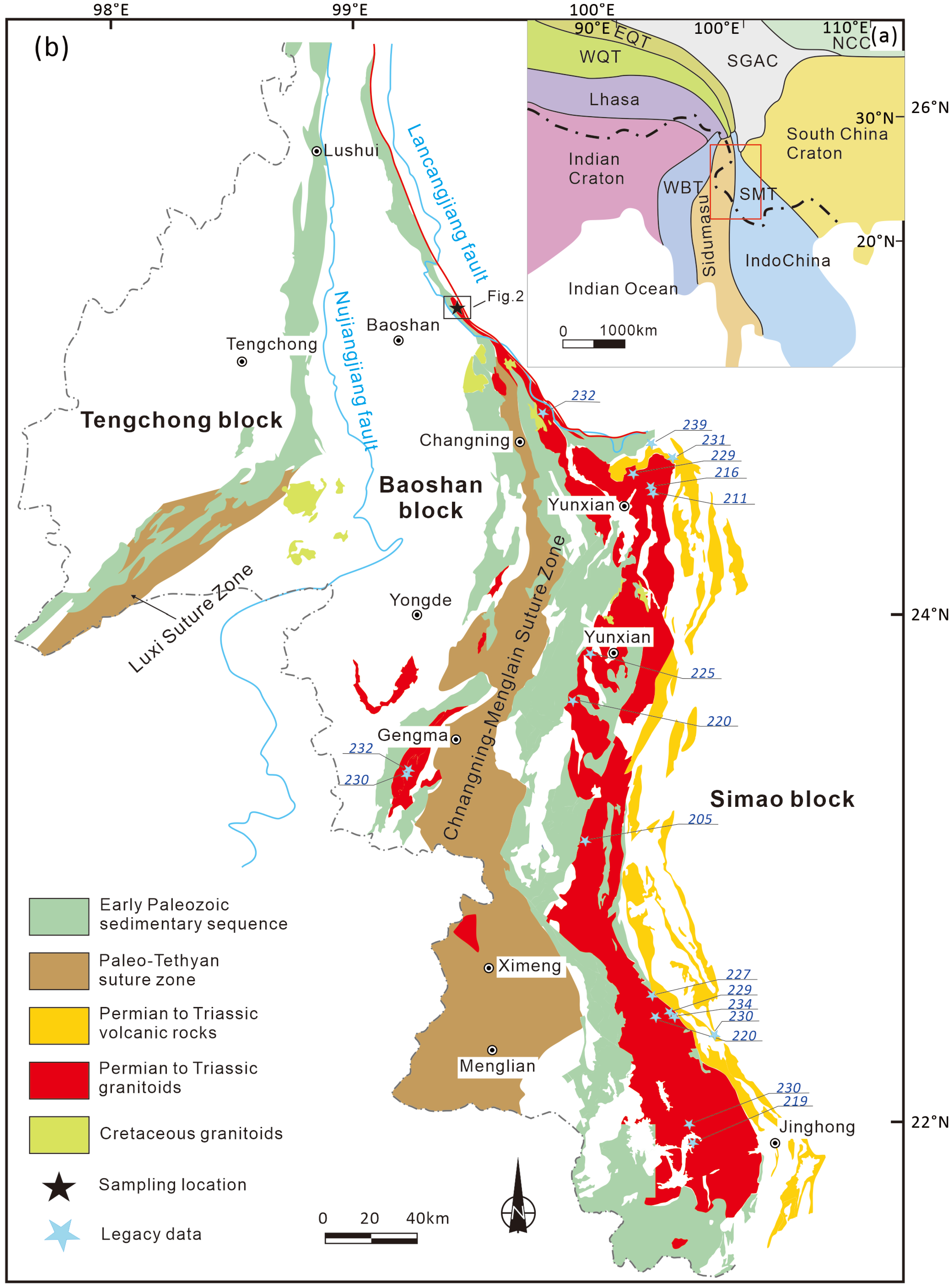
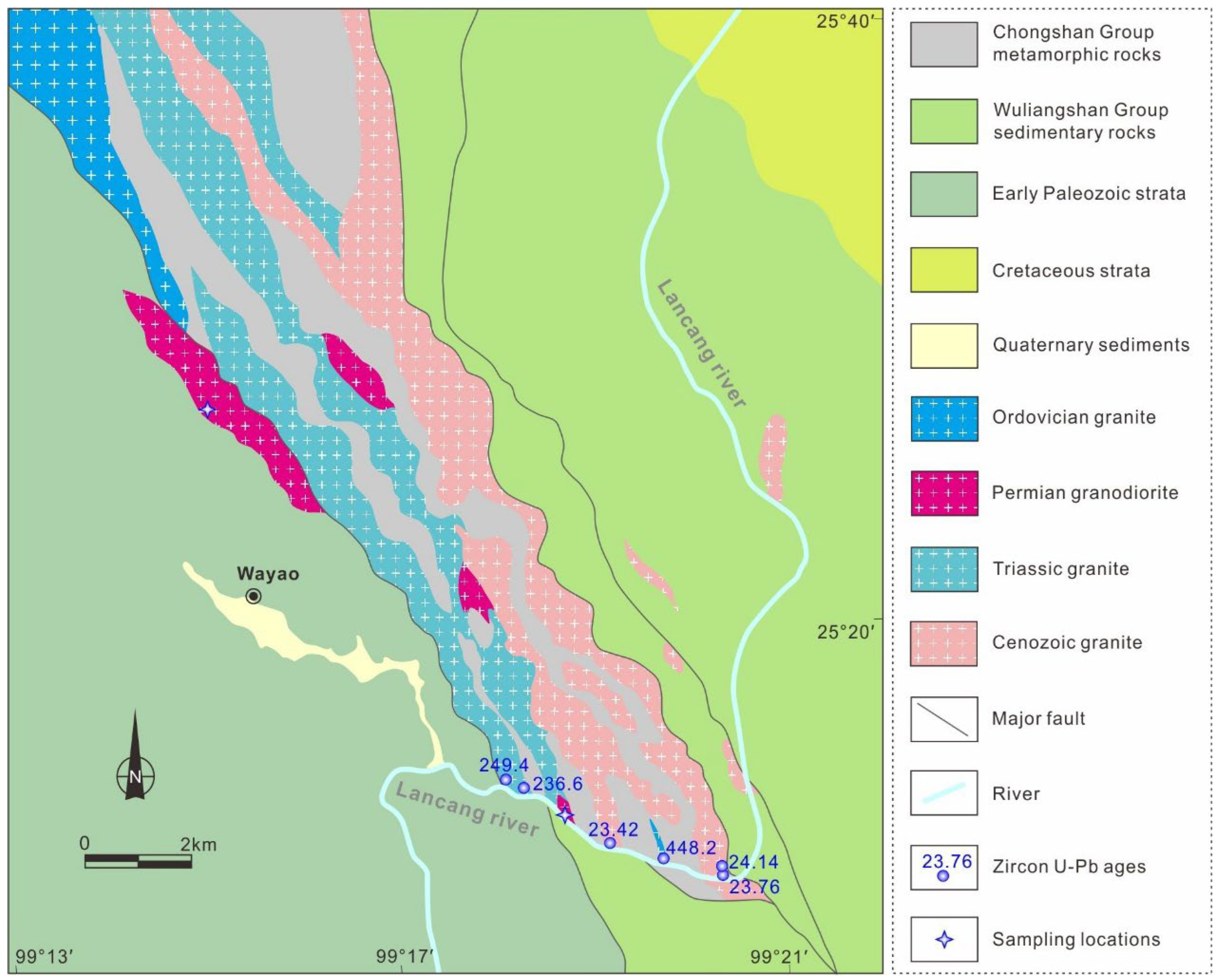
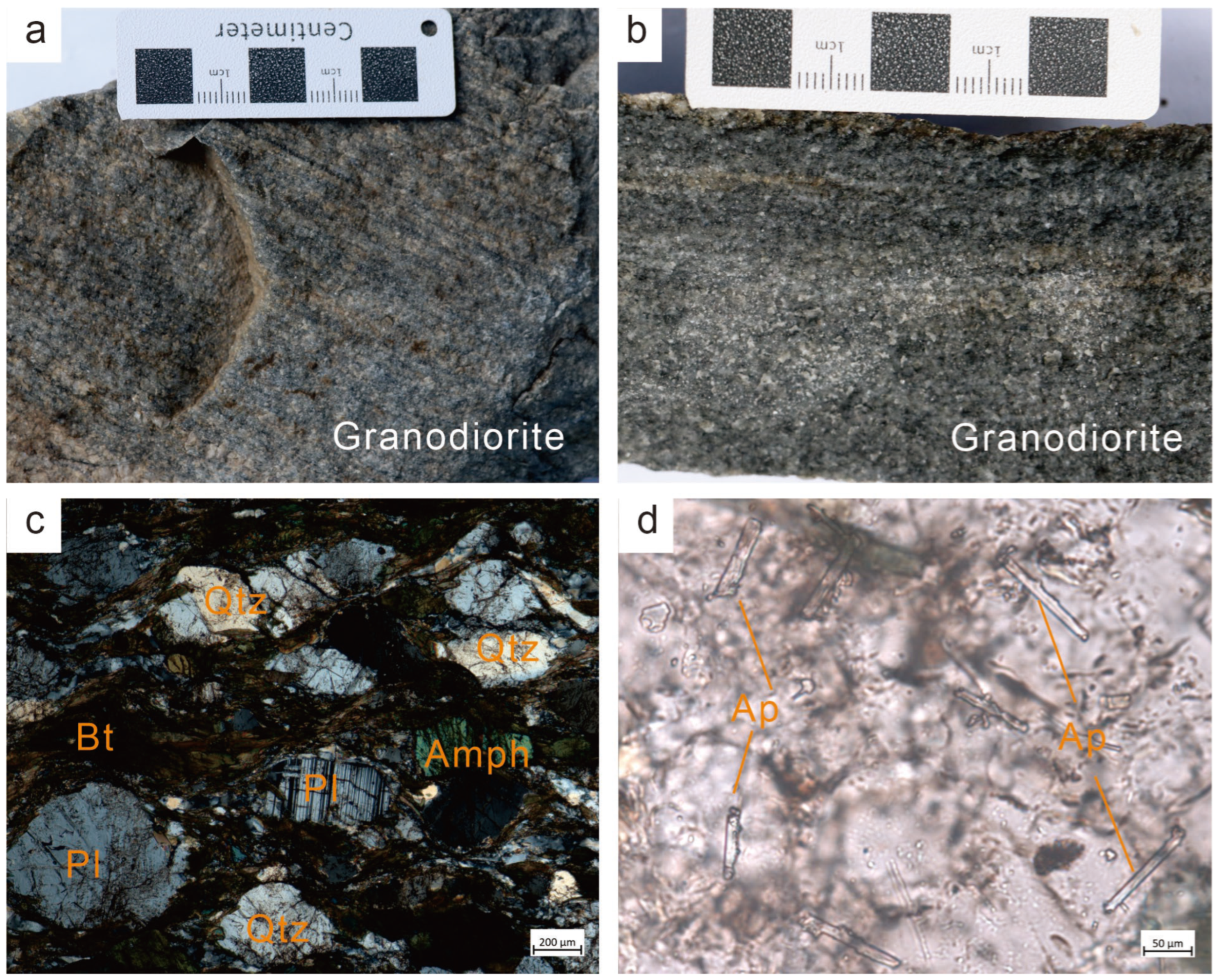
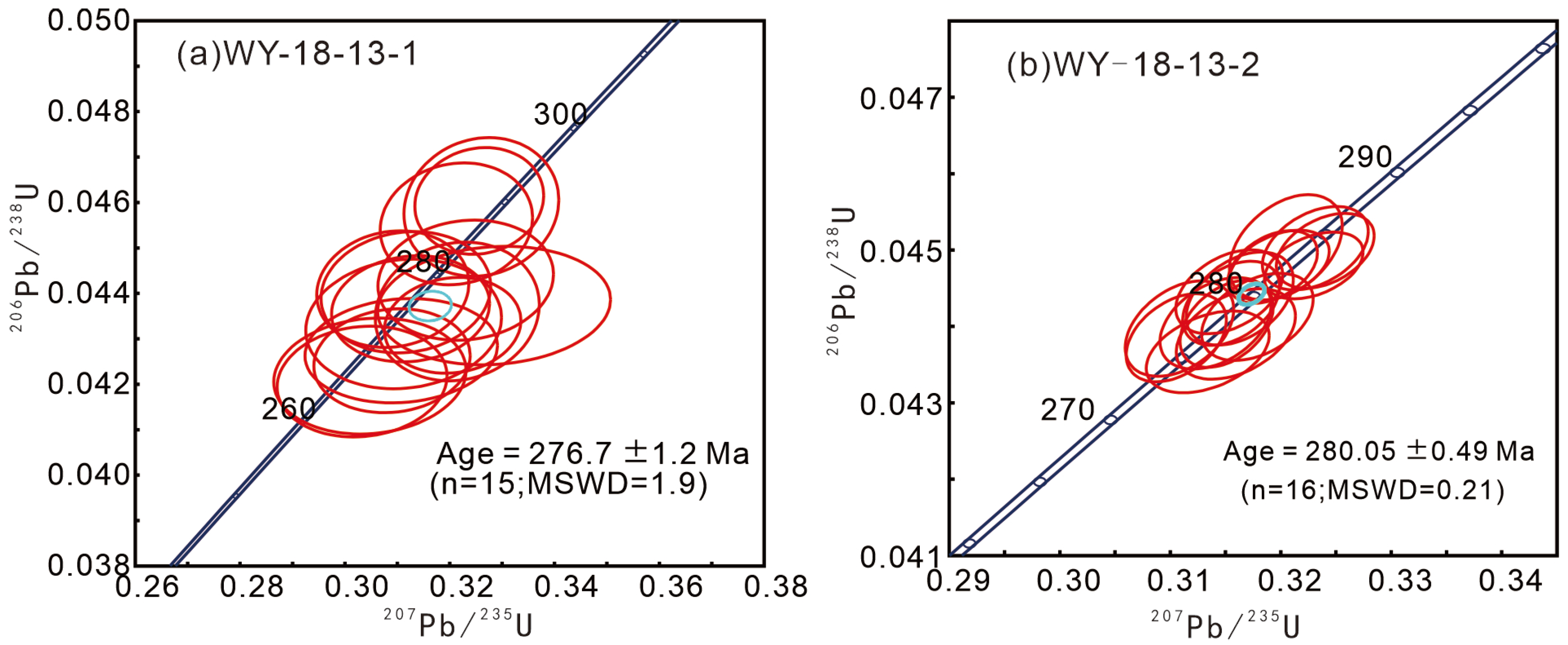

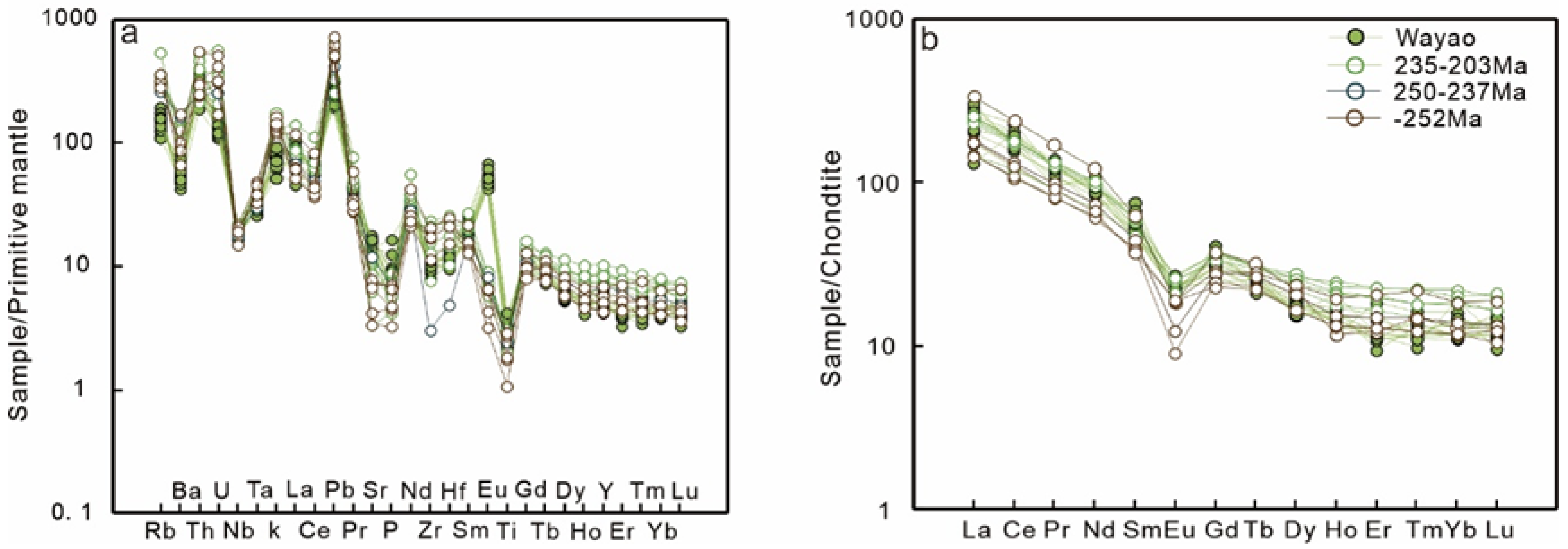
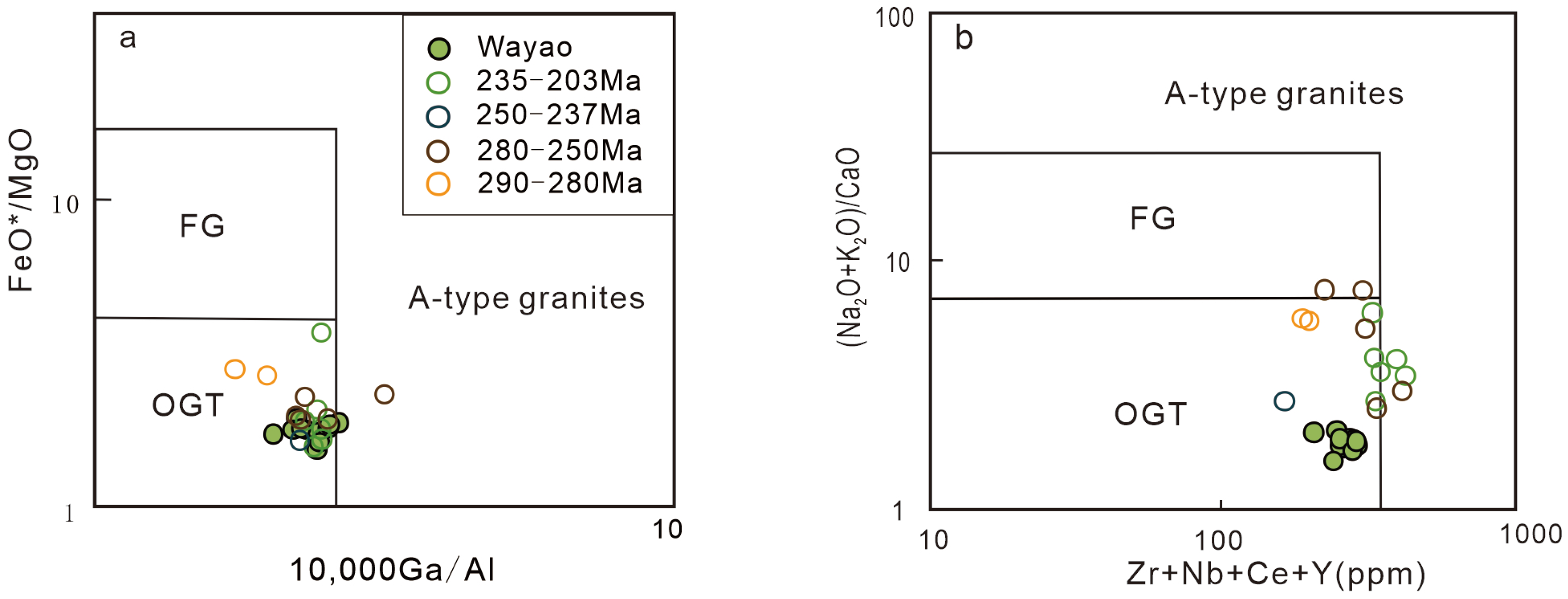
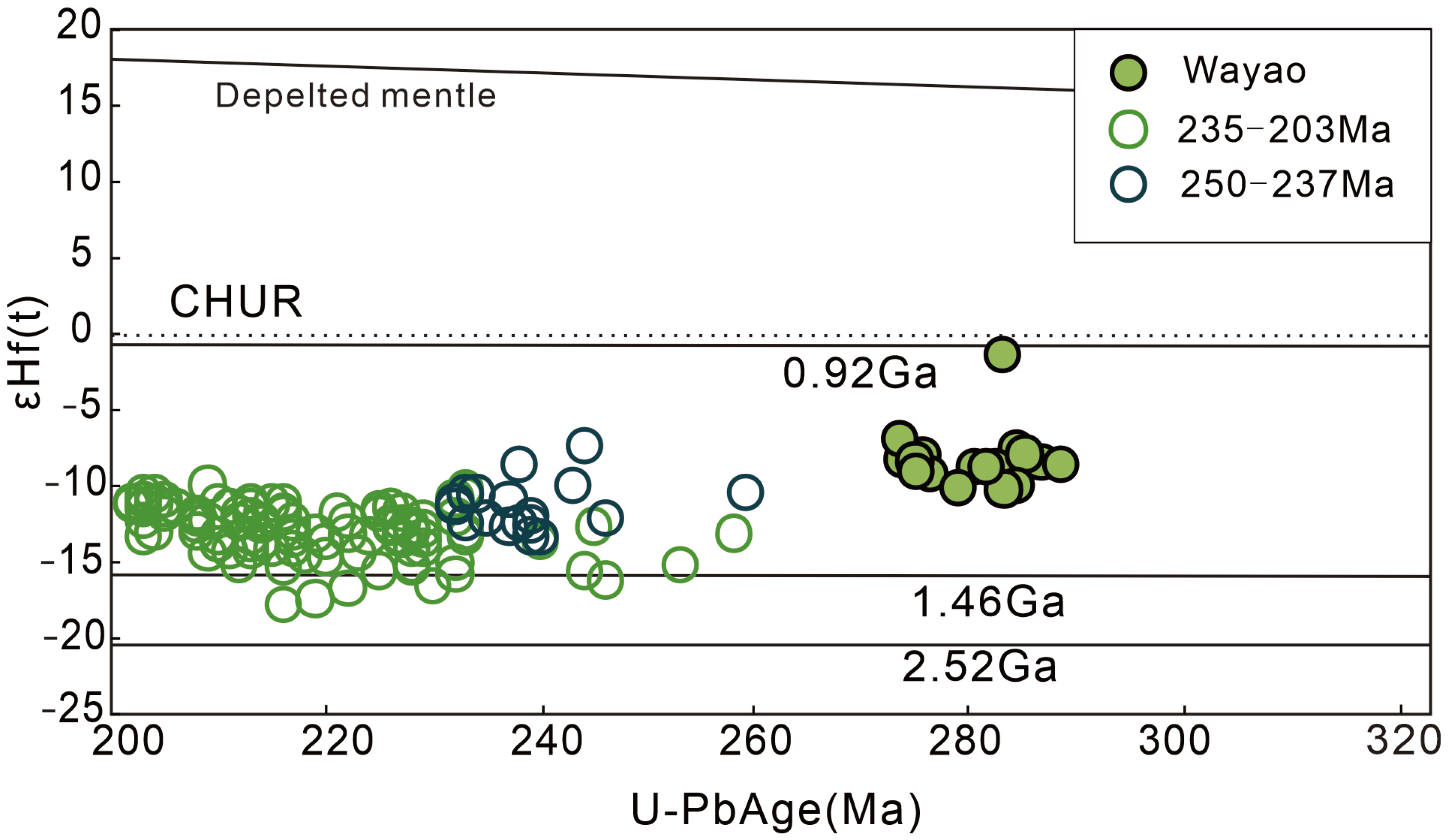
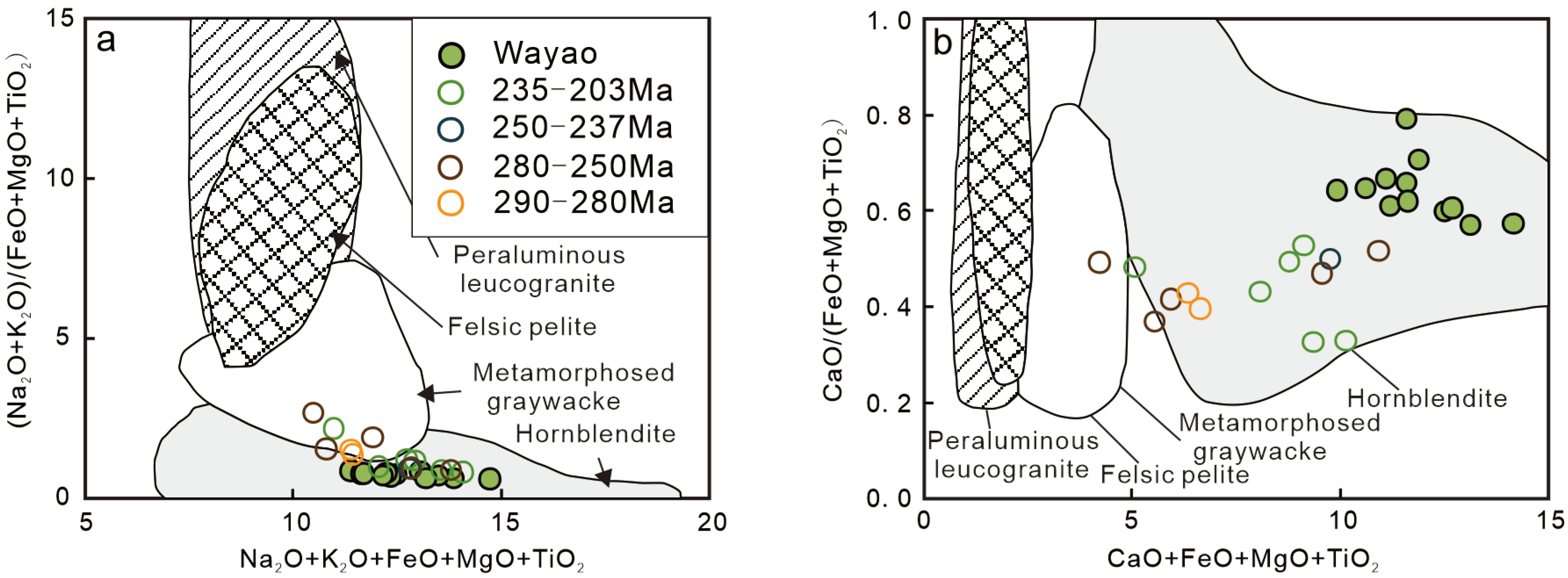
| Sample No. | WY-18-13 | WY-18-14 | WY-18-15 | WY-18-16 | WY-18-17 | WY-18-18 | WY-18-19 | WY-18-20 | WY-18-21 | WY-18-22 | WY-18-23 | WY-18-24 |
|---|---|---|---|---|---|---|---|---|---|---|---|---|
| SiO2 | 65.84 | 64.31 | 65.59 | 66.47 | 67.66 | 65.82 | 64.28 | 65.08 | 66.38 | 63.72 | 64.73 | 66.37 |
| TiO2 | 0.67 | 0.88 | 0.72 | 0.58 | 0.52 | 0.73 | 0.62 | 0.47 | 0.61 | 0.89 | 0.65 | 0.55 |
| Al2O3 | 15.60 | 15.02 | 16.35 | 14.71 | 15.39 | 15.08 | 16.15 | 14.83 | 15.76 | 15.02 | 15.36 | 14.95 |
| TFe2O3 | 4.53 | 5.32 | 4.38 | 4.27 | 4.05 | 4.55 | 5.13 | 4.62 | 4.16 | 5.45 | 4.98 | 4.41 |
| MnO | 0.08 | 0.06 | 0.05 | 0.09 | 0.07 | 0.08 | 0.07 | 0.09 | 0.06 | 0.08 | 0.08 | 0.09 |
| MgO | 2.21 | 2.65 | 2.26 | 2.02 | 1.85 | 2.31 | 2.54 | 2.3 | 2.05 | 3.16 | 2.73 | 2.11 |
| CaO | 4.61 | 4.78 | 4.25 | 5.12 | 3.89 | 4.45 | 4.69 | 4.92 | 4.17 | 5.16 | 4.79 | 4.45 |
| Na2O | 3.24 | 3.55 | 3.47 | 2.95 | 2.9 | 3.36 | 3.78 | 3.62 | 3.03 | 4.19 | 3.18 | 2.87 |
| K2O | 1.93 | 1.95 | 2.07 | 2.28 | 2.45 | 1.82 | 1.92 | 2.48 | 2.18 | 1.55 | 2.12 | 2.71 |
| P2O5 | 0.15 | 0.27 | 0.13 | 0.17 | 0.15 | 0.35 | 0.2 | 0.1 | 0.21 | 0.1 | 0.15 | 0.2 |
| LOI | 0.60 | 0.75 | 0.55 | 0.76 | 0.45 | 0.75 | 0.39 | 0.82 | 0.8 | 0.56 | 0.65 | 0.75 |
| T0TAL | 99.46 | 99.54 | 99.82 | 99.42 | 99.38 | 99.30 | 99.77 | 99.33 | 99.41 | 99.88 | 99.42 | 99.46 |
| Li | 50.82 | 72.11 | 58.32 | 39.48 | 61.25 | 80.39 | 44.57 | 55.19 | 63.37 | 49.23 | 52.98 | 59.69 |
| Be | 2.27 | 2.98 | 3.15 | 2.79 | 4.57 | 3.26 | 3.81 | 4.02 | 3.94 | 3.12 | 3.47 | 4.22 |
| Sc | 11.03 | 11.8 | 13.12 | 9.87 | 12.35 | 10.58 | 15.25 | 13.03 | 12.17 | 10.82 | 11.29 | 12.51 |
| V | 72.81 | 84.42 | 76.71 | 69.73 | 65.38 | 77.19 | 80.62 | 79.37 | 72.15 | 93.25 | 82.16 | 73.94 |
| Cr | 46.53 | 42.15 | 61.36 | 56.39 | 35.71 | 49.94 | 68.22 | 52.39 | 58.52 | 85.35 | 62.64 | 73.64 |
| Co | 10.26 | 12.63 | 11.58 | 9.37 | 13.15 | 10.29 | 10.94 | 9.87 | 9.55 | 10.23 | 11.19 | 11.42 |
| Ni | 9.61 | 9.78 | 10.25 | 12.11 | 8.92 | 10.59 | 12.38 | 9.14 | 10.81 | 13.06 | 9.66 | 10.53 |
| Cu | 15.75 | 17.83 | 8.54 | 9.61 | 12.59 | 14.22 | 15.35 | 22.07 | 14.28 | 19.25 | 13.19 | 15.67 |
| Zn | 99.46 | 75.36 | 108.27 | 90.65 | 95.18 | 86.42 | 112.08 | 103.45 | 97.81 | 100.05 | 95.07 | 89.28 |
| Ga | 18.67 | 18.42 | 17.63 | 20.55 | 18.17 | 19.35 | 21.6 | 17.26 | 18.95 | 19.22 | 19.84 | 20.1 |
| Rb | 69.82 | 122.09 | 108.35 | 76.79 | 68.85 | 110.23 | 95.77 | 78.64 | 92.1 | 100.38 | 85.26 | 98.88 |
| Sr | 344.76 | 289.55 | 356.14 | 330.5 | 328.97 | 290.02 | 310.85 | 325.69 | 368.65 | 340.26 | 338.9 | 345.13 |
| Y | 22.24 | 31.26 | 25.13 | 22.87 | 18.6 | 20.95 | 20.73 | 21.58 | 24.02 | 32.4 | 27.15 | 29.3 |
| Zr | 110.07 | 108.2 | 89.25 | 97.66 | 105.34 | 118.92 | 120.09 | 135.17 | 114.26 | 102.38 | 110.55 | 123.48 |
| Nb | 12.94 | 15.32 | 14.56 | 13.2 | 11.68 | 12.5 | 12.8 | 13.17 | 12.83 | 14.21 | 13.09 | 12.77 |
| Mo | 0.48 | 0.29 | 0.36 | 0.45 | 0.52 | 0.63 | 0.47 | 0.43 | 0.56 | 0.45 | 0.5 | 0.68 |
| Cd | 0.23 | 0.18 | 0.25 | 0.15 | 0.18 | 0.22 | 0.24 | 0.19 | 0.2 | 0.25 | 0.23 | 0.19 |
| In | 0.06 | 0.09 | 0.07 | 0.05 | 0.07 | 0.1 | 0.08 | 0.09 | 0.05 | 0.06 | 0.1 | 0.08 |
| Ba | 340.73 | 290.5 | 358.93 | 472.15 | 558.62 | 360.94 | 320.11 | 435.1 | 380.25 | 402.93 | 500.86 | 345.6 |
| La | 59.31 | 47.1 | 40.65 | 68.13 | 55.92 | 30.9 | 49.18 | 58.06 | 72.35 | 64.29 | 60.4 | 57.2 |
| Ce | 113.12 | 94.62 | 75.07 | 104.15 | 108.6 | 122.36 | 115.7 | 110.23 | 98.44 | 138.2 | 125.17 | 118.65 |
| Pr | 11.96 | 10.9 | 8.73 | 9.05 | 12.37 | 11.55 | 13.06 | 9.64 | 10.39 | 11.38 | 12.22 | 11.8 |
| Nd | 40.80 | 34.2 | 50.62 | 45.18 | 39.06 | 42.5 | 46.34 | 45.26 | 38.45 | 41.15 | 40.3 | 43.48 |
| Sm | 7.22 | 11.38 | 9.2 | 8.38 | 7.55 | 10.26 | 8.05 | 7.39 | 7.16 | 6.93 | 7.8 | 8.51 |
| Eu | 1.24 | 1.29 | 1.24 | 1.53 | 1.38 | 1.32 | 1.57 | 1.22 | 1.19 | 1.45 | 1.3 | 1.28 |
| Gd | 6.15 | 5.08 | 6.76 | 7.48 | 5.52 | 6.04 | 7.36 | 8.35 | 6.23 | 6.5 | 6.92 | 6.31 |
| Tb | 0.86 | 0.94 | 1.03 | 0.9 | 0.78 | 0.83 | 1.15 | 0.87 | 0.86 | 0.94 | 0.95 | 0.99 |
| Dy | 4.45 | 5.23 | 3.85 | 4.08 | 4.69 | 4.32 | 3.93 | 4.77 | 5.14 | 4.15 | 3.99 | 4.48 |
| Ho | 0.82 | 0.66 | 0.95 | 1.16 | 0.85 | 0.88 | 0.93 | 0.78 | 0.74 | 0.83 | 0.8 | 0.97 |
| Er | 1.80 | 3.02 | 1.56 | 1.98 | 2.05 | 2.4 | 1.91 | 1.85 | 1.79 | 1.83 | 1.95 | 2.56 |
| Tm | 0.30 | 0.41 | 0.33 | 0.28 | 0.35 | 0.3 | 0.25 | 0.35 | 0.38 | 0.29 | 0.3 | 0.28 |
| Yb | 1.98 | 2.72 | 2.23 | 1.85 | 1.96 | 2.05 | 3.19 | 1.9 | 2.18 | 2.5 | 2.48 | 2.01 |
| Lu | 0.30 | 0.24 | 0.38 | 0.33 | 0.41 | 0.28 | 0.29 | 0.3 | 0.35 | 0.28 | 0.33 | 0.37 |
| Hf | 3.11 | 4.16 | 4.32 | 3.15 | 3.36 | 3.5 | 2.87 | 3.35 | 3.62 | 3.22 | 3.9 | 3.65 |
| Ta | 1.06 | 1.31 | 1.46 | 1.19 | 1.23 | 1.55 | 1.2 | 1.05 | 1.35 | 1.15 | 1.38 | 1.26 |
| Pb | 15.45 | 21.72 | 18.36 | 13.55 | 22.5 | 19.18 | 18.6 | 16.32 | 15.58 | 14.2 | 17.5 | 16.82 |
| Bi | 0.22 | 0.31 | 0.25 | 0.19 | 0.22 | 0.2 | 0.15 | 0.25 | 0.29 | 0.18 | 0.19 | 0.21 |
| Th | 23.75 | 15.7 | 25.26 | 31.08 | 20.13 | 22.05 | 28.37 | 23.55 | 24.02 | 18.45 | 19.36 | 20.08 |
| U | 2.46 | 2.23 | 3.84 | 2.75 | 3.56 | 4.12 | 2.55 | 2.38 | 3.04 | 3.17 | 2.88 | 2.5 |
| LREE | 233.64 | 199.49 | 185.51 | 236.42 | 224.88 | 218.89 | 233.90 | 231.80 | 227.98 | 263.40 | 247.19 | 240.92 |
| HREE | 16.65 | 18.30 | 17.09 | 18.06 | 16.61 | 17.10 | 19.01 | 19.17 | 17.67 | 17.32 | 17.72 | 17.97 |
| L/R | 14.03 | 10.90 | 10.85 | 13.09 | 13.54 | 12.80 | 12.30 | 12.09 | 12.90 | 15.21 | 13.95 | 13.41 |
| (La/Yb)N | 21.50 | 12.42 | 13.08 | 26.42 | 20.46 | 10.81 | 11.06 | 21.92 | 23.81 | 18.45 | 17.47 | 20.41 |
| (Ce/Yb)N | 15.88 | 9.66 | 9.35 | 15.64 | 15.39 | 16.58 | 10.07 | 16.12 | 12.54 | 15.36 | 14.02 | 16.40 |
| (Sm/Eu)N | 2.21 | 3.34 | 2.81 | 2.08 | 2.07 | 2.95 | 1.94 | 2.30 | 2.28 | 1.81 | 2.27 | 2.52 |
| Sample No. | Rb | Sr | 87Rb/86Sr | 87Sr/86Sr | SE | (87Sr/ 86 Sr) i | Sm | Nd | 147Sm/144Nd | 143Nd/144Nd | SE | εNd(t) | TDM | TDM2 | fcc |
|---|---|---|---|---|---|---|---|---|---|---|---|---|---|---|---|
| WY-18-13 | 69.82 | 344.76 | 0.586376 | 0.709112 | 0.000007 | 0.706890 | 7.22 | 40.80 | 0.1069 | 0.512325 | 0.000007 | −6.1 | 1177 | 1282 | −0.4 |
| WY-18-15 | 108.35 | 356.14 | 0.880941 | 0.709161 | 0.000005 | 0.705659 | 9.20 | 50.62 | 0.1099 | 0.512353 | 0.000005 | −5.6 | 1169 | 1245 | −0.4 |
| WY-18-16 | 76.79 | 330.5 | 0.672778 | 0.709143 | 0.000006 | 0.706435 | 8.38 | 45.18 | 0.1121 | 0.512345 | 0.000004 | −5.7 | 1207 | 1264 | −0.4 |
| WY-18-17 | 68.85 | 328.97 | 0.606019 | 0.70914 | 0.000009 | 0.706742 | 7.55 | 39.06 | 0.1169 | 0.512346 | 0.000005 | −5.7 | 1264 | 1276 | −0.4 |
| WY-18-18 | 110.23 | 290.02 | 1.100552 | 0.709175 | 0.000007 | 0.704644 | 10.26 | 42.50 | 0.1459 | 0.51234 | 0.000003 | −5.8 | 1817 | 1371 | -0.4 |
| WY-18-19 | 95.77 | 310.85 | 0.892107 | 0.709127 | 0.00001 | 0.705657 | 8.05 | 46.34 | 0.1050 | 0.512347 | 0.000004 | −5.7 | 1126 | 1241 | −0.4 |
| WY-18-20 | 78.64 | 325.69 | 0.699162 | 0.709148 | 0.000006 | 0.706385 | 7.39 | 45.26 | 0.0987 | 0.512352 | 0.000011 | −5.6 | 1057 | 1215 | −0.4 |
| WY-18-21 | 92.1 | 368.65 | 0.723409 | 0.709125 | 0.000008 | 0.706285 | 7.16 | 38.45 | 0.1126 | 0.512343 | 0.000004 | −5.8 | 1215 | 1269 | −0.4 |
| WY-18-22 | 100.38 | 340.26 | 0.854230 | 0.709172 | 0.000008 | 0.705915 | 6.93 | 41.15 | 0.1018 | 0.512334 | 0.000002 | −5.9 | 1111 | 1254 | −0.4 |
| Sample No. | 176Hf/177Hf | 1σ | 176Lu/177Hf | 1σ | 176Yb/177Hf | 1σ | εHf(0) | εHf(t) | TDM1 | TDM2 |
|---|---|---|---|---|---|---|---|---|---|---|
| WY18-13_3 | 0.282564 | 0.000013 | 0.000468 | 0.000003 | 0.015403 | 0.000182 | −7.34 | −7.34 | 959 | 1357 |
| WY18-13_5 | 0.282544 | 0.000017 | 0.001161 | 0.000015 | 0.038634 | 0.000411 | −8.06 | −8.06 | 1006 | 1397 |
| WY18-13_25 | 0.282530 | 0.000015 | 0.000770 | 0.000005 | 0.025187 | 0.000050 | −8.56 | −8.56 | 1015 | 1425 |
| WY18-13_6 | 0.282538 | 0.000015 | 0.000568 | 0.000009 | 0.017911 | 0.000383 | −8.26 | −8.26 | 998 | 1408 |
| WY18-13_8 | 0.282551 | 0.000014 | 0.001231 | 0.000038 | 0.043103 | 0.001736 | −7.81 | −7.81 | 998 | 1383 |
| WY18-13_9 | 0.282534 | 0.000013 | 0.000765 | 0.000009 | 0.025933 | 0.000160 | −8.41 | −8.41 | 1009 | 1417 |
| WY18-13_10 | 0.282580 | 0.000014 | 0.000741 | 0.000011 | 0.023304 | 0.000155 | −6.78 | −6.78 | 944 | 1326 |
| WY18-13_31 | 0.282529 | 0.000012 | 0.000566 | 0.000006 | 0.019168 | 0.000345 | −8.60 | −8.60 | 1011 | 1427 |
| WY18-13_14 | 0.282517 | 0.000013 | 0.000735 | 0.000031 | 0.024758 | 0.001214 | −9.03 | −9.03 | 1033 | 1451 |
| WY18-13_15 | 0.282541 | 0.000014 | 0.000630 | 0.000008 | 0.021444 | 0.000330 | −8.18 | −8.18 | 997 | 1404 |
| WY18-13_33 | 0.282490 | 0.000017 | 0.000851 | 0.000034 | 0.030098 | 0.000953 | −9.97 | −9.97 | 1073 | 1503 |
| WY18-13_17 | 0.282530 | 0.000014 | 0.000549 | 0.000013 | 0.018791 | 0.000595 | −8.57 | −8.57 | 1010 | 1426 |
| WY18-13_38 | 0.282497 | 0.000013 | 0.000608 | 0.000011 | 0.020639 | 0.000346 | −9.74 | −9.74 | 1057 | 1490 |
| WY18-13_18 | 0.282734 | 0.000015 | 0.001749 | 0.000024 | 0.062018 | 0.000828 | −1.34 | −1.34 | 749 | 1024 |
| WY18-13_19 | 0.282489 | 0.000014 | 0.001250 | 0.000009 | 0.041314 | 0.000319 | −10.01 | −10.01 | 1086 | 1505 |
| WY18-13_41 | 0.282520 | 0.000015 | 0.000565 | 0.000005 | 0.018907 | 0.000291 | −8.91 | −8.91 | 1024 | 1444 |
| Sample No. | Isotopic Ratios | Isotopic Ages (Ma) | |||||||||||||
|---|---|---|---|---|---|---|---|---|---|---|---|---|---|---|---|
| Pb | Th | U | 207Pb/206Pb | 207Pb/206Pb | 207Pb/235U | 207Pb/235U | 206Pb/238U | 206Pb/238U | 207Pb/206Pb | 207Pb/206Pb | 207Pb/235U | 207Pb/235U | 206Pb/238U | 206Pb/238U | |
| (ppm) | (ppm) | (ppm) | Ratio | 1sigma | Ratio | 1sigma | Ratio | 1sigma | Age (Ma) | 1sigma | Age (Ma) | 1sigma | Age (Ma) | 1sigma | |
| WY-18-13-1 | 9 | 62.2 | 195 | 0.0529 | 0.0021 | 0.3048 | 0.0121 | 0.0422 | 0.0008 | 324 | 88.9 | 270 | 9.4 | 266 | 5.2 |
| WY-18-13-2 | 9 | 63.7 | 176 | 0.0500 | 0.0022 | 0.2938 | 0.0133 | 0.0429 | 0.0009 | 195 | 104 | 262 | 10.5 | 271 | 5.3 |
| WY-18-13-3 | 19 | 145 | 368 | 0.0534 | 0.0018 | 0.3231 | 0.0110 | 0.0443 | 0.0009 | 346 | 50 | 284 | 8.5 | 279 | 5.4 |
| WY-18-13-4 | 12 | 77.7 | 229 | 0.0554 | 0.0017 | 0.3439 | 0.0127 | 0.0449 | 0.0009 | 432 | 65.7 | 300 | 9.6 | 283 | 5.8 |
| WY-18-13-5 | 22 | 192 | 423 | 0.0510 | 0.0015 | 0.3092 | 0.0096 | 0.0441 | 0.0008 | 239 | 66.7 | 274 | 7.4 | 278 | 5.2 |
| WY-18-13-6 | 27 | 147 | 523 | 0.0517 | 0.0014 | 0.3260 | 0.0098 | 0.0459 | 0.0010 | 272 | 61.1 | 287 | 7.5 | 289 | 6.2 |
| WY-18-13-7 | 10 | 63.5 | 200 | 0.0525 | 0.0020 | 0.3112 | 0.0123 | 0.0433 | 0.0009 | 306 | 87.0 | 275 | 9.5 | 273 | 5.8 |
| WY-18-13-8 | 24 | 169 | 473 | 0.0512 | 0.0016 | 0.3116 | 0.0107 | 0.0440 | 0.0009 | 250 | 72.2 | 275 | 8.3 | 278 | 5.4 |
| WY-18-13-9 | 10 | 74 | 188 | 0.0546 | 0.0023 | 0.3285 | 0.0147 | 0.0437 | 0.0009 | 394 | 94.4 | 288 | 11.2 | 276 | 5.3 |
| WY-18-13-10 | 22 | 180 | 446 | 0.0530 | 0.0017 | 0.3090 | 0.0099 | 0.0425 | 0.0008 | 328 | 72.2 | 273 | 7.6 | 268 | 4.7 |
| WY-18-13-11 | 18 | 178 | 360 | 0.0538 | 0.0019 | 0.3023 | 0.0109 | 0.0410 | 0.0008 | 361 | 80 | 268 | 8.5 | 259 | 4.8 |
| WY-18-13-12 | 21 | 145 | 429 | 0.0524 | 0.0018 | 0.3033 | 0.0107 | 0.0421 | 0.0008 | 306 | 77.8 | 269 | 8.3 | 266 | 5.0 |
| WY-18-13-13 | 12 | 67.6 | 242 | 0.0568 | 0.0021 | 0.3309 | 0.0127 | 0.0426 | 0.0009 | 483 | 47.2 | 290 | 9.7 | 269 | 5.8 |
| WY-18-13-14 | 24 | 168.7 | 476 | 0.0520 | 0.0016 | 0.3126 | 0.0100 | 0.0437 | 0.0008 | 287 | 69 | 276 | 7.7 | 275 | 4.8 |
| WY-18-13-15 | 13 | 86.9 | 260 | 0.0530 | 0.0020 | 0.3108 | 0.0121 | 0.0427 | 0.0008 | 328 | 88.9 | 275 | 9.4 | 270 | 4.7 |
| WY-18-13-16 | 78 | 329 | 1568 | 0.0513 | 0.0012 | 0.3256 | 0.0081 | 0.0460 | 0.0008 | 254 | 53.7 | 286 | 6.2 | 290 | 4.8 |
| WY-18-13-17 | 29 | 130 | 617 | 0.0541 | 0.0015 | 0.3206 | 0.0086 | 0.0433 | 0.0007 | 372 | 63 | 282 | 6.6 | 273 | 4.3 |
| WY-18-13-18 | 50 | 241 | 994 | 0.0512 | 0.0013 | 0.3213 | 0.0096 | 0.0455 | 0.0009 | 256 | 59.2 | 283 | 7.4 | 287 | 5.5 |
| WY-18-13-19 | 26 | 179 | 539 | 0.0540 | 0.0016 | 0.3215 | 0.0103 | 0.0436 | 0.0010 | 372 | 64.8 | 283 | 7.9 | 275 | 6.2 |
| WY-18-13-20 | 14 | 169 | 2065 | 0.0482 | 0.0016 | 0.0506 | 0.0034 | 0.0074 | 0.0004 | 122 | 81.5 | 50.1 | 3.3 | 47.3 | 2.5 |
| WY-18-13-21 | 25 | 133 | 469 | 0.0510 | 0.0015 | 0.3444 | 0.0110 | 0.0488 | 0.0008 | 239 | 66.7 | 301 | 8.3 | 307 | 5.2 |
| WY18-13_22 | 38 | 279 | 848 | 0.0514 | 0.0003 | 0.2904 | 0.0036 | 0.0410 | 0.0005 | 257 | 39 | 259 | 3 | 259 | 3 |
| WY18-13_23 | 66 | 664 | 1326 | 0.0514 | 0.0002 | 0.3106 | 0.0030 | 0.0439 | 0.0004 | 257 | 39 | 275 | 2 | 277 | 2 |
| WY18-13_24 | 26 | 202 | 519 | 0.0515 | 0.0003 | 0.3153 | 0.0032 | 0.0445 | 0.0004 | 261 | 10 | 278 | 2 | 280 | 2 |
| WY18-13_25 | 28 | 251 | 552 | 0.0523 | 0.0003 | 0.3179 | 0.0033 | 0.0441 | 0.0004 | 298 | 19 | 280 | 3 | 278 | 2 |
| WY18-13_26 | 22 | 200 | 451 | 0.0520 | 0.0004 | 0.3134 | 0.0037 | 0.0437 | 0.0004 | 287 | -14 | 277 | 3 | 276 | 2 |
| WY18-13_27 | 69 | 818 | 1348 | 0.0520 | 0.0003 | 0.3094 | 0.0031 | 0.0432 | 0.0004 | 283 | 11 | 274 | 2 | 273 | 2 |
| WY18-13_28 | 36 | 250 | 724 | 0.0517 | 0.0003 | 0.3155 | 0.0029 | 0.0443 | 0.0004 | 272 | 15 | 278 | 2 | 279 | 2 |
| WY18-13_29 | 32 | 184 | 653 | 0.0524 | 0.0003 | 0.3275 | 0.0039 | 0.0454 | 0.0005 | 302 | 15 | 288 | 3 | 286 | 3 |
| WY18-13_30 | 45 | 274 | 930 | 0.0517 | 0.0003 | 0.3141 | 0.0033 | 0.0440 | 0.0004 | 272 | 13 | 277 | 3 | 278 | 2 |
| WY18-13_31 | 77 | 498 | 1549 | 0.0517 | 0.0002 | 0.3193 | 0.0027 | 0.0448 | 0.0003 | 272 | 9 | 281 | 2 | 282 | 2 |
| WY18-13_32 | 378 | 934 | 8011 | 0.0516 | 0.0001 | 0.3205 | 0.0034 | 0.0450 | 0.0005 | 333 | 7 | 282 | 3 | 284 | 3 |
| WY18-13_33 | 30 | 218 | 598 | 0.0522 | 0.0003 | 0.3159 | 0.0036 | 0.0439 | 0.0004 | 295 | 15 | 279 | 3 | 277 | 2 |
| WY18-13_34 | 26 | 195 | 507 | 0.0521 | 0.0003 | 0.3249 | 0.0035 | 0.0453 | 0.0004 | 287 | 15 | 286 | 3 | 286 | 2 |
| WY18-13_35 | 41 | 251 | 822 | 0.0521 | 0.0003 | 0.3231 | 0.0032 | 0.0450 | 0.0004 | 287 | 13 | 284 | 2 | 284 | 2 |
| WY18-13_36 | 81 | 1173 | 1458 | 0.0517 | 0.0002 | 0.3163 | 0.0032 | 0.0444 | 0.0004 | 272 | 9 | 279 | 2 | 280 | 2 |
| WY18-13_37 | 25 | 195 | 493 | 0.0518 | 0.0003 | 0.3199 | 0.0030 | 0.0448 | 0.0003 | 276 | 19 | 282 | 2 | 283 | 2 |
| WY18-13_38 | 29 | 216 | 576 | 0.0523 | 0.0003 | 0.3230 | 0.0029 | 0.0448 | 0.0003 | 298 | 18 | 284 | 2 | 282 | 2 |
| WY18-13_39 | 37 | 293 | 728 | 0.0523 | 0.0003 | 0.3240 | 0.0029 | 0.0450 | 0.0003 | 298 | 13 | 285 | 2 | 284 | 2 |
| WY18-13_40 | 185 | 769 | 3928 | 0.0519 | 0.0002 | 0.3151 | 0.0028 | 0.0440 | 0.0004 | 283 | 12 | 278 | 2 | 278 | 2 |
| WY18-13_41 | 69 | 680 | 1353 | 0.0513 | 0.0003 | 0.3108 | 0.0032 | 0.0440 | 0.0004 | 254 | 11 | 275 | 3 | 277 | 3 |
Disclaimer/Publisher’s Note: The statements, opinions and data contained in all publications are solely those of the individual author(s) and contributor(s) and not of MDPI and/or the editor(s). MDPI and/or the editor(s) disclaim responsibility for any injury to people or property resulting from any ideas, methods, instructions or products referred to in the content. |
© 2025 by the authors. Licensee MDPI, Basel, Switzerland. This article is an open access article distributed under the terms and conditions of the Creative Commons Attribution (CC BY) license (https://creativecommons.org/licenses/by/4.0/).
Share and Cite
Liu, J.; Jia, Z.; Wang, J.; Zhao, F.; Luo, J.; Xu, F.; Chen, F. The Petrogenesis of Early Permian Granodiorites in the Northern Segment of the Changning-Menglian Suture Zone, Western Yunnan, and Their Tectonic Implications. Minerals 2025, 15, 894. https://doi.org/10.3390/min15090894
Liu J, Jia Z, Wang J, Zhao F, Luo J, Xu F, Chen F. The Petrogenesis of Early Permian Granodiorites in the Northern Segment of the Changning-Menglian Suture Zone, Western Yunnan, and Their Tectonic Implications. Minerals. 2025; 15(9):894. https://doi.org/10.3390/min15090894
Chicago/Turabian StyleLiu, Jiajia, Zhen Jia, Jiyuan Wang, Feng Zhao, Junbao Luo, Feiyang Xu, and Fuchuan Chen. 2025. "The Petrogenesis of Early Permian Granodiorites in the Northern Segment of the Changning-Menglian Suture Zone, Western Yunnan, and Their Tectonic Implications" Minerals 15, no. 9: 894. https://doi.org/10.3390/min15090894
APA StyleLiu, J., Jia, Z., Wang, J., Zhao, F., Luo, J., Xu, F., & Chen, F. (2025). The Petrogenesis of Early Permian Granodiorites in the Northern Segment of the Changning-Menglian Suture Zone, Western Yunnan, and Their Tectonic Implications. Minerals, 15(9), 894. https://doi.org/10.3390/min15090894






